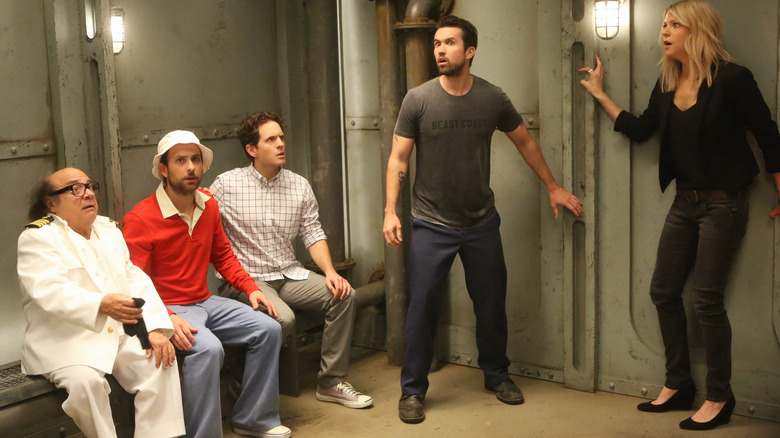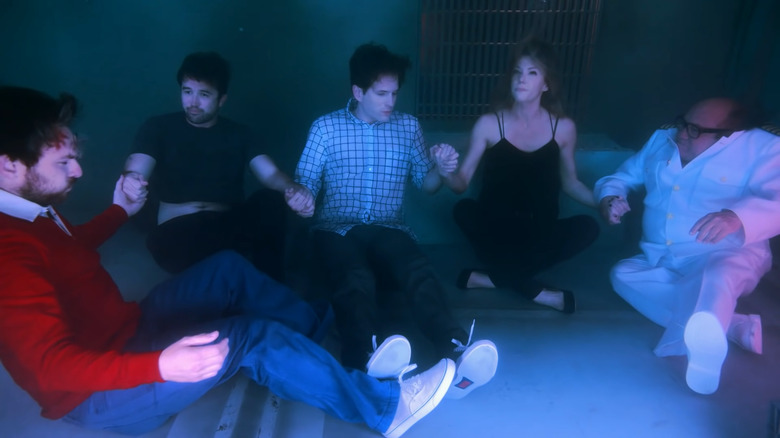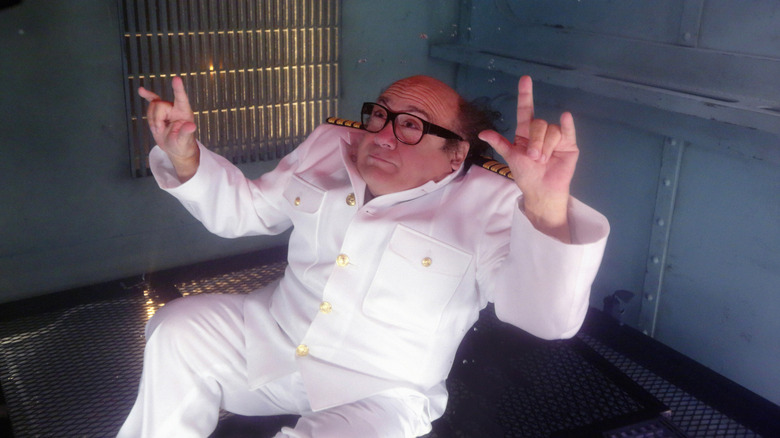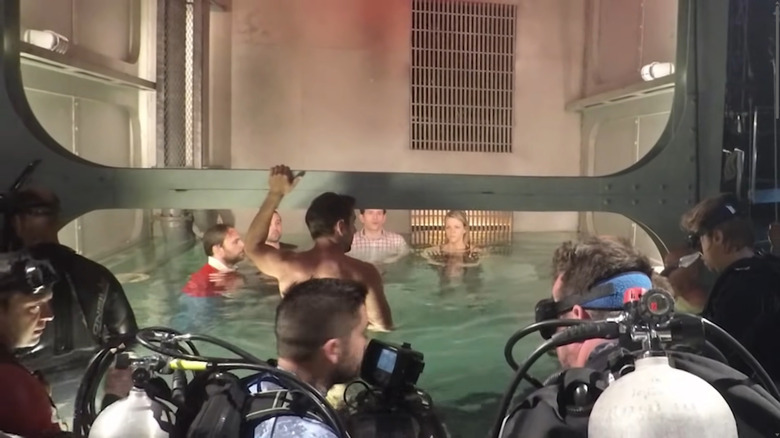The It's Always Sunny In Philadelphia Set Glenn Howerton Hated (And Why He Changed His Mind)
"It's Always Sunny In Philadelphia" has come a long way from its low-budget roots. Before the show got picked up by FX, the creators' first few episodes were home-made and only possible because they'd managed to find an affordable camera. Nowadays, the show is funded so well that there don't seem to be any limits. They could film in a completely different location for an episode or two (or a whole mini-season), experiment with claymation, and bring in all sorts of surprising guest stars. For Glenn Howerton, a co-creator of the show and the actor who plays Dennis, it was the season 11 finale that served as the most gratuitous example of the show's rising budget.
"The Gang Goes to Hell: Part Two" takes place almost entirely in one room, the prison cell on a cruise ship after the gang had tried and failed to have a relaxing vacation. This might not sound expensive — if anything, keeping the whole episode on a single set seems remarkably cheap — except for how the show had to build a giant pool around the set and build it so the set could rise and lower as much as necessary. The room gets flooded with water as the episode goes on, and this one element made the episode's production process far more complicated than it had ever been.
"The first time I saw it I was like, 'This is the stupidest thing I've ever seen in my life,'" Howerton explained in a Behind the Scenes clip. "'This is such a giant waste of money, such a giant waste of time, such a giant waste of resources.' I was like, 'There has got to be a simpler and easier way to do this.'"
Water complicates everything
Of course, Howerton changed his tune pretty quickly. "To be fair, when we got there and we started shooting the scene, and I realized how much we were going to have to constantly be changing the level of the water, I was like, 'Okay, I see why we have to film this in a water tank.' [...] If you tried to fill four walls with water, you wouldn't be able to constantly control the level of the water ... but also, it's kind of a three-wall proscenium. You gotta shoot the damn thing, so there's gotta be a cameraman outside of the room shooting it."
This is part of why directors and actors alike tend to hate filming scenes with lots of water. There are a million different complications that come with realistically depicting the ocean and the effects it'd have on any given set. The crew usually has to build a giant tank of water because the ocean itself is too unpredictable to work with, and then you have to deal with concerns like bubbles forming on the lens, water-involved acting being a miserable experience for the performers, and the whole thing being a much longer process than regular filming. When Daniel Radcliffe filmed all those underwater scenes in "Harry Potter and the Goblet of Fire," he recalled how the crew was only able to get about "seven seconds" of "usable footage" a day. Even more famously, James Cameron had to wait 13 years (and invent some new film tech in the process) just to finish making "Avatar: The Way of Water."
Many water-related difficulties
For the "Always Sunny" actors, there were two problems that came with this new set of theirs. As Glenn Howerton explained, "The hardest thing about it was, we had to shoot scenes of us just getting in [the water], like 'Okay, I guess we're going to die,' just drifting down at the bottom. The thing is, anyone who has been in the pool [knows] you go to the deep end, you go to the bottom, you gotta do that thing [pinches nostrils] otherwise your ears will explode." He's referring to a scene at the end of the episode where Dennis is supposed to fall gracefully to the bottom of the floor without touching his face, and the process was agonizing for him: "I was trying to make it really subtle, and I almost made my head explode."
On a slightly more dramatic scale is what happened to Danny DeVito: "We almost drowned him," Charlie Day explained in an interview with Conan O'Brien. As he explained:
"Danny's incredibly buoyant, like a buoy. It was hard to get him down, so we really had to weigh him down to get the shot where we're all holding hands underwater ... When the shot was over and we were all trying to get back to the surface for air... because we weighed [Danny] down he sort of got halfway and was going nowhere ... [There was] that look of panic in his eyes like, 'This is the end, these guys killed me.'"
Luckily, some safety divers pulled DeVito out before his untimely demise, and he lived to joke about it with the rest of the gang. "It was a good experience," he told Extra TV, "Because I had lived a good life, and it flashed before my eyes in that scene."
One of the show's most ambitious episodes
The difficulty of filming with water is why even big-budget films often choose to stay out of the water altogether, although that also comes with plenty of drawbacks. They have to rely on tricks like using fans and adjusting the frame rate to mimic the way water affects people's hair, all while accepting that it still probably won't look anywhere near as good as "Avatar 2."
Considering that most sitcoms go their whole run without ever putting the camera below sea level, it's impressive that "It's Always Sunny" even tried it at all. Then again, "The Gang Goes to Hell" is already ambitious in every other way that counts: In run-time, character work, and even thematically. The whole second half is a homage to "No Exit," a 1940s play where three people trapped in a room slowly realize that hell is not made up of evil demons or torture chambers, but simply of other people. Sure enough, the Paddy's crew drive themselves insane purely by being around each other, deprived of any outside force to rail against. Even when they see a chance to escape the water, they still try to drag each other down.
The whole episode underlines the idea that these characters are terrible for each other, that they're all harming themselves by sticking around, but much like when the characters of "No Exit" are faced with the ambiguous empty hallway, they all prefer the safety of their group than the unknown world outside of it. It's a dark, surreal episode, and much of that feeling is evoked by the change of set. "At the end of the day," Howerton concluded, "I was glad we had the tank."



